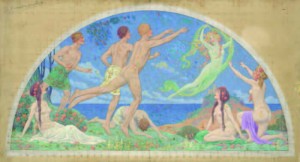 In 1915, when the Panama-Pacific International Exposition (PPIE) opened, San Francisco was already a gay mecca for those in the know. Some 25 years beforehand, author, playwright and poet Oscar Wilde wrote in The Picture of Dorian Gray: “It’s an odd thing, but anyone who disappears is said to be seen in San Francisco. It must be a delightful city and possess all the attractions of the next world.”
In 1915, when the Panama-Pacific International Exposition (PPIE) opened, San Francisco was already a gay mecca for those in the know. Some 25 years beforehand, author, playwright and poet Oscar Wilde wrote in The Picture of Dorian Gray: “It’s an odd thing, but anyone who disappears is said to be seen in San Francisco. It must be a delightful city and possess all the attractions of the next world.”
LGBT people did “disappear,” or at least try to from the law, only to be found later at places like the Dash, a gay bar at 574 Pacific Street. The city, according to sfgayhistory.com, closed Dash in 1908 after police found its patrons performing oral sex under the dresses of cross-dressing male entertainers. Before the closure, such entertainers would dance on top of tables, inviting the attention.
At the time, the gay community was growing in the Barbary Coast neighborhood, the area now covered by the Financial District and North Beach. In later years, it would be the home to San Francisco’s first lesbian bar (Mona’s Club on Union Street), and the first leather bar (Why Not at 518 Ellis).
In addition to heading over to the Barbary Coast, LGBT visitors to the Panama-Pacific International Exposition could have brought with them Marcel Proust’s then new In Search of Lost Time. The work marked the first time a modern Western author treated homosexuality openly in literature.
Yet, as for the Dash’s closure, this was not a great time to be out of the closet. In the fall of 1914, just before PPIE opened, some 500 gay men were arrested as “social vagrants,” which led to the passage of a law prohibiting “acts technically known as fellatio and cunnilingus.” Those convicted could spend up to 15 years in prison.
When you visit Jewel City at the de Young, consider then what those before us faced. It is little wonder that so many works by closeted LGBT artists absolutely sizzle with queer energy, likely serving as a creative release, a silent shout for connection, and an expression of their true selves.
Recent Comments